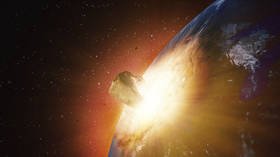Space force assemble? 1km-wide asteroid headed this way at 57,000kmph

An enormous 3,000-ft asteroid is set to make a close flyby of the Earth this coming Saturday at a speed which, if it hits, could produce widespread devastation across the planet.
Measuring between 1,443ft and 3,248ft (440m to 990m) in diameter, the giant space rock, which is officially known as 2002 PZ39, dwarfs the Burj Khalifa, Empire State Building, the Shard in London, and even the oft-discussed, pseudo-apocalyptic Bennu asteroid.
Also on rt.com Asteroid EXPLODES over Earth after travelling from beyond Mars (VIDEO)Traveling at roughly 35,567mph (57,240km/h), an object at that speed and this size would hit with the force of a major thermonuclear bomb, creating vast firestorms, earthquakes, and potentially even tsunamis depending on where exactly it hit.
“We believe anything larger than one to two kilometers – one kilometer is a little more than one-half mile – could have worldwide effects,” NASA said previously.
According to the 2018 White House National Near-Earth Object Preparedness Strategy and Action Plan, asteroids of 1km in diameter and above can cause damage on a global scale.
Thankfully, however, during its close approach on Saturday February 15, at 6.05am EST, the space rock will miss us by more than 3.58 million miles (5.77 million km).
Also on rt.com Russia to track EARTH-THREATENING asteroids from robot-inhabited nuclear-powered polar Moon baseStill, NASA classifies any Near-Earth Object (NEO) which comes within 4.65 million miles of us as “potentially hazardous.”
2002 PZ39 will make another close flyby of the Earth in August 2034 after having paid a visit to Venus in June that year, though it’s too early to tell just how close it will come then.
Think your friends would be interested? Share this story!













